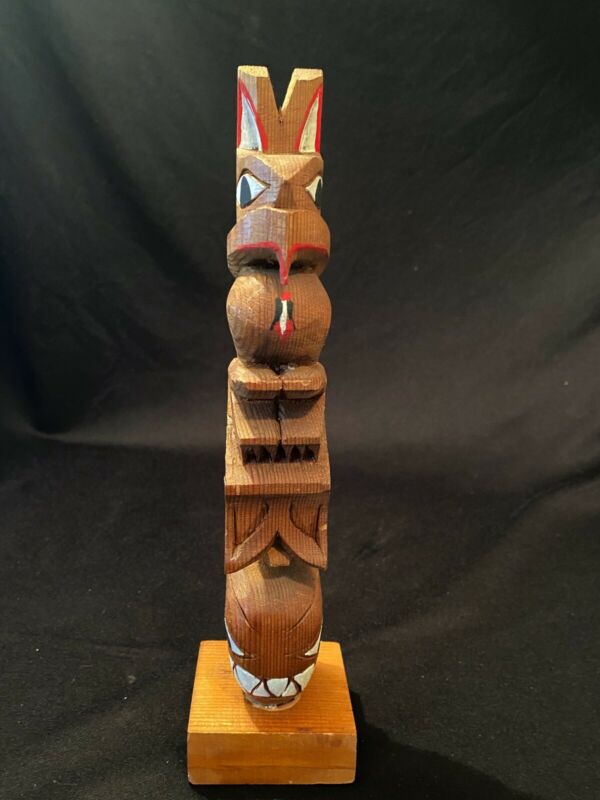-40%
1988 Barry Herem Cannibal Bird Ltd Ed Serigraph
$ 316.8
- Description
- Size Guide
Description
This is a large, long sold out, and intriguing print from an edition of 195 by established artist Barry Herem. Titled 'Cannibal Bird' it depicts a Hamat'sa dancer. It measures appx 26" x 19" and will be shipped unframed. Please note that this print is from 1988 and there may be unforeseen discoloration under the matte. No refunds will be given for this unforeseen discoloration.The Kwakwaka’wakw culture, based in the north of Vancouver Island and on the mainland of southwest British Columbia, traditionally divides its year into ceremonial months and non-ceremonial months. The Tsetseka, or ceremonial season, begins in the late autumn and is marked by feasting and the activation of ancient dancing societies. There are four main societies in Kwakwaka’wakw culture: the Winalagilis, the Atlakim, the Dluwalakha (or Klasila), and the
Hamat’sa
. The secretive Hamat’sa society and its dancing rituals are based around the initiations of a novice dancer. The ceremonial winter Hamat’sa dance often lasts for several days and contains a large cast of characters who educate, terrify and challenge the nominated novice. While there are numerous representational spirits and creatures involved in this dancing ceremony, the primary figures are those of birds who inhabit the Sky-World and interact with human life below. These birds are guided by the spirit Baxbaxwalanuksiwe ("Man-Eater at the North End of the World") and include the Cannibal (or Hamat’sa) Raven, the Hokhokw, and the Crooked Beak. While the Hamat’sa ceremony is complex and contains many characters, Baxbaxwalanuksiwe’s birds are popular with First Nations artists because they have the potential of being both representationally identifiable and intellectually provocative. In the carving of masks, the Hamat’sa Raven, the Hokhokw and the Crooked Beak are often built with articulated beaks, which snap open and shut during dancing performances.
Both the figurative and abstract work of Barry Herem owe much to natural forms and often to essential shapes from the ethnic or "form line" art of the Pacific Northwest Coast. He has renewed and extended these forms into true contemporary art through a knowing reinvention of them, often with a modernistic flair in what he calls "equal parts invention and assimilation." Herem works in a wide variety of mediums: bronze, cast paper, glass, steel, aluminum plate, silver, fabric, wood and as a serigraph print-maker. He is particularly recognized for instigating innovative use of some of these materials in Northwest Coast styles being the first to use cast paper (1984), one of the first to utilize bronze (1973), and his pioneering use of enameled aluminum plate and steel dates from 1982. Herem has produced many large works of public and private sculpture throughout the Northwest. Outstanding projects include two 10- by 30- foot walls of enameled aluminum plate - stylized whales - for Alaska Airlines. Another large, semi-public sculpture is his "Northern Light", a 40-foot long work in iridescent acrylic rod, originally located in the Alaska Airlines boardroom at the Sea-Tac International Airport. A five piece bronze and cedar collection of sculptures may be seen in Seattle's Gateway Tower. Through the Washington State Arts Commission he has installed an 18-foot high eagle-form wind vane in bronze and aluminum (Klahowya school, Silverdale, Wa.) and among others, works in glass and steel for the Forensics lab of the State Patrol in Vancouver, Wa. Another notable piece is "Council", a bronze grouping of fourteen Northwest style masks, welded into an irregular 4 foot "square", single-piece sculpture. Trained as a writer/journalist Herem has also published many articles, poems (some award winning) letters and photographs in books and magazines: Time/Life, Harpers, Architectural Digest, Connoisseur, Seattle Times and P.I., American Indian Art et al. His work has been noted in the New York Times and other publications. He has done extensive archaeological/anthropological style field work as well, having directed a massive survey of native Alaskan historic sites for Sealaska Corporation of Juneau, Alaska in 1973-74 which resulted in a 900-page descriptive directory of same. Herem is also noted as a lively lecturer (through Humanities Washington and many private venues) and is well known for his many summer canoe adventures in the coastal wilds of British Columbia and Alaska.









